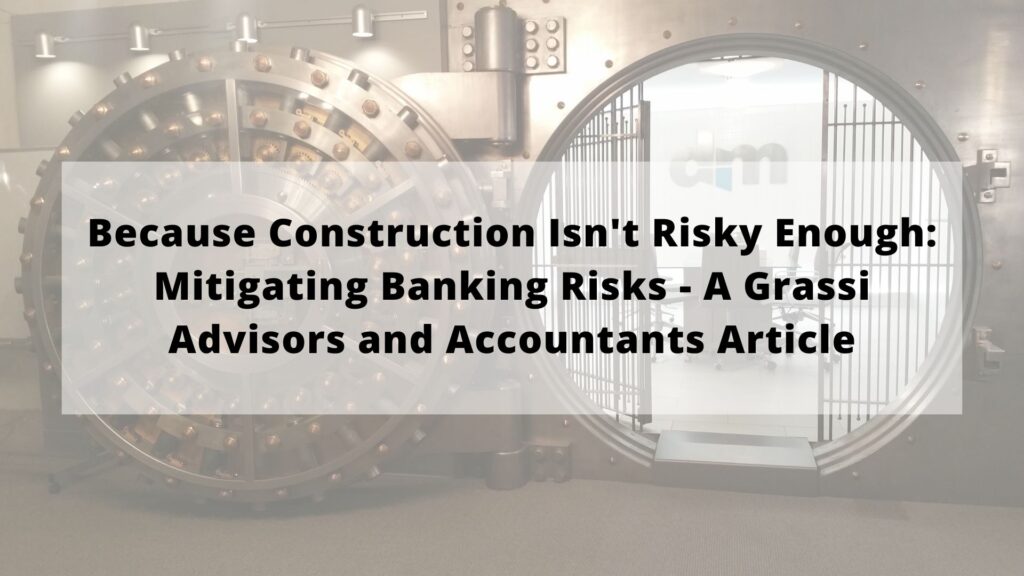
The Law Offices of John Caravella, P.C. does not own this content. This content was created by Carl Oliveri, and was published to the Grassi Advisors and Accountants Blog on March 14th, 2023. To view the full article, please click here.
I have always said the construction industry is the most dynamic industry to advise. The executives are entrepreneurial and the technology is cutting edge, not to mention the sector allows us to contribute to a changing metropolitan landscape, leading to long, respected legacies. But with these fulfilling rewards does come an elevated level of risk. The chance for failure is lurking everywhere – within one bad job, mismanagement of cash flow in the CFO’s office, and lack of skills in the job site and back office.
Credit providers to the construction industry, such as banks and sureties, are constantly evaluating and weighing these risks, as well as their own, when making lending or bonding decisions. This scrutiny of risk is even higher when the credit provider is asked to increase a line of credit or support a bond request out of the contractor’s normal scope. The underwriting that goes into these credit decisions is comprehensive and involves analyzing a variety of financial and non-financial data. At times, this process does wear the construction company executive thin, but it is intended to protect interests and mitigate risks for the financial institution.
Considering current events within the banking industry, the tables have turned and a new risk has emerged for the construction company. Namely, how does the company mitigate the risk of a potential bank failure?
While some could argue exposure to financial loss from the risk of a contractor’s bank closing (or being forced to close) is a long shot, it has emerged as a factor that cannot be ignored. In other words, while it is different than the traditional risks associated with insurance or subcontractor default, it is still a risk, nonetheless.
While not an all-inclusive list, the following are some immediate steps construction company leaders can take to address the risk of bank failure and the potential impact on your cash:
- Cash Flow Forecasting – Managing and forecasting cash flow for a construction company is different than other businesses, mainly because the modeling should be done on a project-by-project basis and then rolled up into a global model. This method assists the construction financial manager in identifying when peaks and valleys will occur for investing opportunities and borrowing needs, respectively. Factoring any perceived bank closure risk into this report will position the contractor to take proactive steps before the only step left is to get on the bank run line.
- Address the Concentration of Credit Risk – As cliché as it sounds, “don’t keep all of your eggs in one basket.” Best practices call for more than one banking relationship, even if it is as simple as having a piece of your liquidity in a money market account. It goes without saying that certain cash balance levels must be maintained at the primary bank to cover payroll, fund taxes or fulfill other operating obligations. But understanding when excess cash will exist (utilizing cash flow forecasting, as noted above) will give you the opportunity to sweep funds out to a second financial institution and help mitigate the concentration risk. Further, savvy construction companies will make these decisions based on an understanding of the types of accounts their cash is deposited in, how it is being protected and its growth potential, regardless of the bank.
- Understanding Your Line of Credit – A line of credit acts as a safety net for contractors who must front costs on projects in between requisitions, so it is not unusual to see contractors go in and out of their lending facility. This is an essential tool for construction companies, but you must understand the underlying terms and conditions of your line of credit. If bank risk is intensifying, it may not be as simple as transferring funds to another bank. The covenants may call for you to maintain all of the company’s cash at the bank or be granted permission to start a relationship with another financial house to keep the line of credit in good standing. You should also be aware of any terms in the agreement that grant the bank the ability to offset any outstanding debt to liquidity, regardless of providing notice of such action. Finally, know what type of line of credit you have. For example, a demand line of credit allows the lender to call the loan due at any time.
- Addressing and Planning for the Risk – At the onset of the COVID-19 pandemic, developing and deploying response plans, for both the office and job site, was a major focus. The industry has watched as these pandemic-centric plans morphed into a “what’s next” emergency response plan. Much like having a response plan for a cyberattack, weather event or whatever else is “next,” the construction contractor should develop and deploy a plan to respond to the risk of their bank closing. Yes, in simplest terms, the response is to get the cash out of the bank. But incorporating the three prior steps into one formal companywide document, while engaging in scenario training, will put you one step ahead (and hopefully out) of the bank run line.
- Consult with Your Professionals – The construction industry is unique, and advisors to the industry have unique perspectives and talents to lend to it. Proactive contractors who want to start mitigating this risk should talk to their advisors to hear what their other clients are doing in terms of developing a response plan and diversifying their cash balances and portfolios. Your professionals may also have insights directly from the bank that could help you make an immediate or longer-term decision.
Knowing which banks are friendly to the construction industry is a great place to start. While the larger banks seem safe to house cash and have a primary banking relationship with, construction does not always fit their risk profile as they may not properly underwrite the industry.
No amount of preparation can make anything in the construction industry risk-free, but taking proactive steps to address marketplace changes and insulating your business from as much risk as possible could mean the difference between profitability or failure.
Grassi’s Construction team will continue to monitor how the industry’s lending community reacts to the ongoing disturbances in the banking market and provide you with the guidance you need to mitigate risk to your construction company.
Listen now for our next Construction Leaders Live Video Session to learn more about these risk management strategies and developing area of risk.
 John Caravella Esq., is a construction attorney and formerly practicing project architect at The Law Office of John Caravella, P.C., representing architects, engineers, contractors, subcontractors, and owners in all phases of contract preparation, litigation, and arbitration across New York and Florida. He also serves as an arbitrator to the American Arbitration Association Construction Industry Panel. Mr. Caravella can be reached by email: [email protected] or (631) 608-1346.
John Caravella Esq., is a construction attorney and formerly practicing project architect at The Law Office of John Caravella, P.C., representing architects, engineers, contractors, subcontractors, and owners in all phases of contract preparation, litigation, and arbitration across New York and Florida. He also serves as an arbitrator to the American Arbitration Association Construction Industry Panel. Mr. Caravella can be reached by email: [email protected] or (631) 608-1346.
The information provided on this website does not, and is not intended to, constitute legal advice; instead, all information, content, and materials available on this site are for general informational purposes only. Readers of this website should contact their attorney to obtain advice with respect to any particular legal matter. No reader, user, or browser of this site should act or refrain from acting on the basis of information on this site without first seeking legal advice from counsel in the relevant jurisdiction. Only your individual attorney can provide assurances that the information contained herein – and your interpretation of it – is applicable or appropriate to your particular situation. Use of, and access to, this website or any of the links or resources contained within the site do not create an attorney-client relationship between the reader, user, or browser and website authors, contributors, contributing law firms, or committee members and their respective employers.
Carl Oliveri is the Construction Practice Leader and a partner at Grassi. Carl possesses over 20 years of experience advising owners and executives within the Construction industry, particularly in regards to project-centric and companywide financial modeling, operational strategy development, financial statement attest services and income tax method analysis. This extensive industry experience allows him to provide insight and advice to construction clients on marketplace trends and best practices.
A thought leader in the industry, Carl has presented at national construction conferences hosted by the American Institute of Certified Public Accountants (AICPA) and Construction Industry CPAs and Consultants (CICPAC) associations and across the Metropolitan area, including at the New York State Society of Certified Public Accountants (NYSSCPA) Construction Conference and the New York metropolitan trade associations’ events. Additionally, he has published articles on an array of contemporaneous issues impacting the construction community.
Carl is currently participating on the Construction Financial Management Association’s (CFMA) Emerging Issues Task Force and is a member of the National Association of Surety Bond Producers CPA Advisory Board. Prior to that, he served as a member of the Executive Committee of CICPAC, where he currently serves as the Thought Leader Committee chair. He has also served on the board for the New York City Chapter of CFMA, held an at-large position on the board of the Institute of Certified Construction Industry Financial Professionals (ICCIFP), and was the chairperson for the NYSSCPA Construction Contractors Committee.
Other professional affiliations include membership in the AICPA and the worldwide and New York City chapters of the Association of Certified Fraud Examiners.
Carl earned his Bachelor of Science degree in Accounting and his Masters of Business Administration with a concentration in Management from the York College of Pennsylvania.
